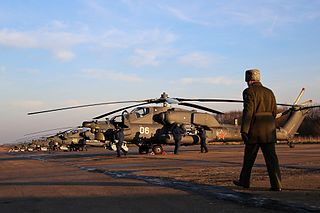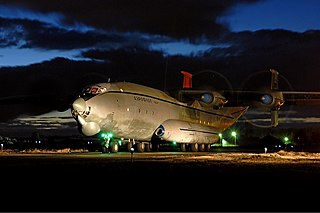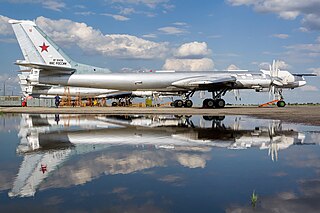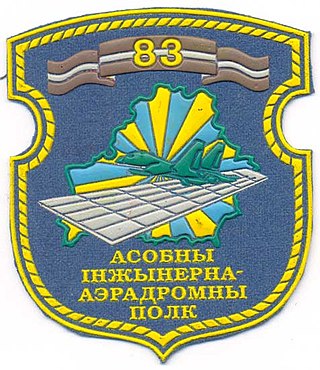
The Tupolev Tu-22M is a supersonic, variable-sweep wing, long-range strategic and maritime strike bomber developed by the Tupolev Design Bureau in the 1960s. The bomber was reported as being designated Tu-26 by Western intelligence at one time. During the Cold War, the Tu-22M was operated by the Soviet Air Forces (VVS) in a missile carrier strategic bombing role, and by the Soviet Naval Aviation in a long-range maritime anti-shipping role. As of 2021, there were 66 of the aircraft in service.

Belaya is a significant Russian Aerospace Forces Long-Range Aviation base in Usolsky District, Irkutsk Oblast, Russia, located 18 kilometres (11 mi) north of Usolye-Sibirskoye and 85 kilometres (53 mi) northwest of Irkutsk. From 2009 it has sometimes been known as Srednii. It has significant ramp space and 38 bomber revetments.

Ukrainka is one of Russia's largest strategic Long Range Aviation bases in the Russian Far East. Located in Amur Oblast, Russia, 28 km north of Belogorsk, and 8 km north of the town of Seryshevo, it is a major nuclear bomber base, with large tarmacs and nearly 40 revetments.

Raadi Airfield(ICAO: EETR) is a former air base in Estonia located in Raadi, 4 km (2.5 mi) northeast of Tartu. The land once belonged to Raadi Manor and is now the new site of the Estonian National Museum.

Soltsy-2 is an air base in Novgorod Oblast, Russia located 2 km north of Soltsy and 72 km southwest of Novgorod. It contains large aircraft revetments, with a separate compound of 9 hardened areas about 1 mile from the airfield.

Long-Range Aviation is a sub-branch of the Russian Aerospace Forces responsible for delivering long-range nuclear or conventional strikes by aircraft. The Russian Long Range Aviation and its now-dissolved Ukrainian counterpart were both previously part of the Soviet Air Forces, before it was split into the Air Forces of its many successor states, most notably the Russian Air Force and Ukrainian Air Force. Those branches were tasked with long-range bombardment of strategic targets with nuclear weapons.
Smirnykh is an abandoned Russian Air Force airbase in Sakhalin, Russia located 2 km east of the village of the same name. It appeared in June 1966 KH-7 imagery with a runway length of 2,000 m. It was expanded sometime after this to 2,500 m with a new extension of revetments added.

Ostrov is a Russian Aerospace Forces air base in Pskov Oblast, Russia located 7 km southeast of Ostrov and 57 km south of Pskov. It was subordinate to the Baltic Fleet and was a nuclear bomber facility with 15 very large revetments on the east side of the airfield and about 30 small revetments on the west side. As many as 63 Tupolev Tu-16s were based here. A US intelligence analysis in 1984 identified a normal complement of 52 Tu-16 aircraft at Ostrov. The base hosted the Russian Navy's 444th Center for Combat Employment and Retraining of Personnel Naval Aviation.

Migalovo is an air base in Tver Oblast, Russia located 10 km west of Tver. It is a large military airlift base. It currently houses all of Russia's remaining Antonov An-22 fleet. It is an Ilyushin Il-76 base, with some Antonov An-12 aircraft stored.

Dyagilevo is an air base in Ryazan Oblast, Russia, 3 km west of Ryazan. It serves as a training center for Russia's strategic bomber force.

Engels-2 is a strategic bomber military airbase in Russia located 14 kilometres (8.7 mi) east of Saratov. Engels is a major bomber operations base, and is Russia's sole operating location for the Tupolev Tu-160 strategic bomber. The base has a 3,500-metre (11,500 ft) runway and about 10 large revetments. It is named after the nearby city of Engels, which is named after the Communist philosopher, Friedrich Engels.

Ozerne is an air base of the Ukrainian Air Force located near Ozerne, Zhytomyr Oblast, Ukraine.

Pryluky is an air base in Chernihiv Oblast, Ukraine located 6 km west of Pryluky. This airfield was Ukraine's primary Tupolev Tu-160 bomber base. There are revetments for 20 large aircraft.
Chagan was an air base in Semipalatinsk, Kazakhstan, that served as a major Cold War bomber base under the 37th Air Army, Soviet Long Range Aviation. It contains significant tarmac space and over 50 revetments. Until at least 1980 it served as one of three bases for the Soviet Union's Tupolev Tu-95 "Bear" long-range bomber fleet. The nearby Dolon Southwest, a former airfield 32 km to the south, was probably a dispersal field and no longer exists.
The 37th Air Army of the High Supreme Command was the strategic bomber force of the Russian Air Force from 1998 to 2009. It was equipped with Tupolev Tu-95MS and Tu-160 armed with nuclear cruise missiles, and the intermediate range Tu-22M3 bombers.

Poltava Air Base is a military airfield located approximately 8 km (5.0 mi) northwest of Poltava, Ukraine. It is one of two airfields near Poltava, the other being Poltava Airport.

The 22nd Guards Donbas Red Banner Heavy Bomber Aviation Division is a division of the Russian Aerospace Force's Long-Range Aviation branch having previously been a Soviet Air Forces formation. It was a Long Range Aviation division active from 1942 to 2008–9. Included in the 37th Air Army High Command. Commander of the division was Major General Alexander Blazhenko. It saw illustrious service during the Second World War, including supply of the Red Army in the Demyansk Pocket and the bombing of Berlin.
326th Tarnopolsky Order of Kutuzov Heavy Bomber Air Division is an Aviation Division of the Long Range Aviation of Russia. It was previously part of the 37th Air Army of the Supreme High Command. It was originally formed as the 326th Night Bomber Aviation Division, formed at Yegoryevsk in Moscow Oblast on 10 October 1943. On 23 June 1944, it was renamed the 326th Bomber Aviation Division.

Babruysk Air Base is a military airfield of the Air and Air Defence Force of Belarus, located in the south-western outskirts of Babruysk (Bobruisk), Belarus. The 83rd Separate Order of the Red Star Engineer-Aerodrome Regiment is at the base, which also functions as a spare airfield. It used to be a Soviet Long-Range Aviation air base.

The Long Range Aviation Group ; abbr. AGDA / АГДА), was a military organisation, subordinate to the Central High Command of the Ukrainian Air Force, which included the long-range aircraft of Ukraine. Ukrainian Long Range Aviation was disbanded in 2007.




















